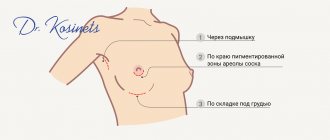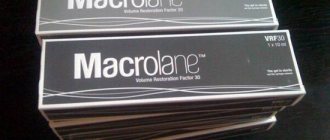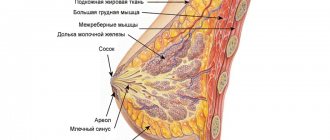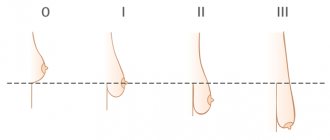Choosing an incision site for breast augmentation
The surgical approach or incision site for any surgical intervention is selected depending on the characteristics of the operation. It is important to choose the correct surgical approach in plastic surgery, because you need an invisible scar that remains after the operation. Therefore, most often the incision sites are determined in natural folds, which make it easy to hide the scar. However, any breast augmentation technique determines that it is important not only to correctly place the incision site, but also to preserve the natural functioning of the mammary gland, which is an important organ of exocrine secretion. In total, the breast consists of more than two dozen segments, united by systems of milk ducts. Moreover, these ducts function not only during lactation, but throughout life. The occurrence of various diseases of the mammary gland is also accompanied by the appearance of fluid that flows through the milk ducts. Therefore, the intersection of the ducts causes problems both in the diagnosis of breast diseases and during lactation - mastitis or lactocele, cysts that fill with milk, can develop.
Most often, three surgical access sites are used during breast augmentation operations, depending on the choice of one or another layer where the implant will be placed.
- The most common is an incision in the crease under the breast or infrared. More than 92% of breast correction operations are performed through this incision. The length of such an incision is 4-5 cm, and from the point of view of safety and ease of access for the surgeon, this type of access is considered optimal. Using an inframammary or inframammary incision: the implant is placed in the abdominal area of the pectoralis major muscle, which is dense in this area and recovers more easily. Moreover, in this case there is no need to cut off the muscle from the sternum. Consequently, the implant is covered with muscle tissue and possible negative consequences such as twitching of the lower muscle edge or the appearance of a “washboard” are eliminated.
- The second most popular is the periareolar incision, or an incision along the edge of the areola. From the surgeon's point of view, this placement of the surgical approach is convenient, but for the patient this operation is the most traumatic. The thing is that, regardless of the direction of dissection of the glandular tissue (vertical or horizontal), with this type of incision at least 1-2 milk ducts are damaged. Consequently, it is subsequently impossible to guarantee the safety of lactation and breastfeeding, and the diagnosis of breast diseases becomes much more complicated. The reason for this is the impossibility of fusion of the milk ducts after dissection. In addition, the implant, if a breast augmentation technique with a periareolar incision is used, is not located in a complete muscle pocket, since the pectoral muscle is cut off from the lower fixation lines during the operation to avoid overstretching the muscle. As a result, even in the first days after surgery, the lower edge of the implant can be easily felt.
- The least visible incision is in the armpit. At the same time, the quality of the implant bed is quite low, especially if it is necessary to place it in a full muscle pocket. This is due to the large distance from the incision site to the edge of the bed (from 15 to 20 centimeters), which requires the use of long tools. Accordingly, the use of long instruments reduces the accuracy of surgical operations. As a result of the operation, the lower lines of fixation of the pectoralis major muscle are most often broken, which leads to unevenness of the lower edge of the mammary gland.
There is another technique that is practiced today in American clinics. The surgical access site in this case is hidden in the navel. However, only implants that are filled with saline can be installed in this way. It is simply impossible to install other types of implants through this type of surgical approach.
Contact us for a free video consultation >>









